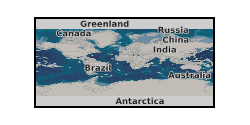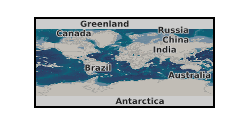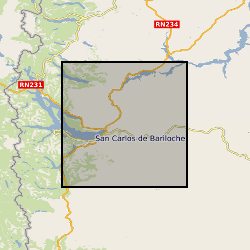MS Excel
Type of resources
Available actions
Topics
Keywords
Contact for the resource
Provided by
Years
Formats
Representation types
Update frequencies
Scale
-

Major, trace element and REE analyses of muds and mudstones from selected intervals from all of the holes. Location of the drill holes are given in the Exp. 352 cruise report (Reagan et al)
-

This excel spreadsheet contains P-wave and S-wave velocity and attenuation data calculated with a novel rock physics model for hydrate bearing sediments. The model has been published in: Marín-Moreno, H., S. K. Sahoo, and A. I. Best (2017), Theoretical modeling insights into elastic wave attenuation mechanisms in marine sediments with pore-filling methane hydrate, Journal of Geophysical Research: Solid Earth, 122(3), 1835-1847, doi:10.1002/2016JB013577.
-

Volcanic ash samples were collected and analysed following the 2015 eruption of Calbuco volcano, Chile. Datasets uploaded are: Calbuco2015 Probe Data - excel Calbuco2015 Locations and Grain Size – excel Calbuco Deposit Measurements grl54177-sup-0002-tables3 Published as supplement to A.R. van Eaton et al (2016) Volcanic lightning and plume behavior reveal evolving hazards during the April 2015 eruption of Calbuco volcano, Chile, Geophysical Research Letters 43 (7), 3563-3571 Electron Probe Micro Analysis Major element compositions of plagioclase, groundmass glass and melt inclusions were analysed with a JEOL JXA-8600 wavelength-dispersive electron microprobe (EMP), equipped with four spectrometers, at the Research Laboratory for Archaeology and the History of Art, University of Oxford using a defocused beam (5¿m), low beam current (4nA) and accelerating voltage of 15 kV. Full analytical conditions are detailed in Rawson et al. (2015). Secondary standards used were Gor128-G and StHs/80-G for glass (Jochum et al., 2006). Glass (melt inclusion and groundmass) totals were normalised to 100% to account for variable secondary hydration. Stoichiometry and charge balancing was used to determine the amount of Fe2O3 and FeO in plagioclase. Pyroxene and magnetite grains were analysed with a defocused beam (5¿m), higher beam current (10nA), and an accelerating voltage of 15 kV. Secondary standards used were hornblende (USNM 111356), Pyrope (USNM 1143968) and ilmenite (USNM 96189; (Jarosewich et al., 1980). Stoichiometry and charge balancing was used to determine the amounts of Fe2O3 and FeO, following Droop (1987). Thickness and Grain size analysis Ash fallout thicknesses were measured in the field shortly after deposition, and samples collected for follow-up analysis of grainsize and chemical composition. Grain size analysis was conducted using a Malvern Laser Particle Sizer Mastersizer 2000 at the University of Oxford.
-

Geomechanical strength data of mudstone samples collected from the Gunthorpe Member, of the Sidmouth Mudstone Formation of the Mercia Mudstone Group. Testing includes Uniaxial Compressive Strength (UCS), Indirect Tensile Strength (ITS) and Triaxial strength testing completed at the University of Leeds (UoL) and Point Load testing and thermal loading testing completed at the British Geological Survey (BGS). All sample preparation, preservation and testing were completed to the specification outlined by the ISRM (2007) unless otherwise stated. For all Triaxial testing, each sample was deformed under standard triaxial stress conditions, where the primary principal stress corresponds to the axial stress and the intermediate and minimum principal stresses are equal to that of the confining pressure. The data are separated into individual Excel files (.xlsx), with each file representing a single test. Each file contains time, force, stress, displacement, and strain data.
-

Stable Isotope and trace element analyses (Ca, Sr, Mg, Fe and Mn concentrations) derived from Cretaceous Belemnites including Duvalia tornajoensis, D. cf. lata constricta, D. binervia, D. cf. emericii, Hibolithes, H. cf. jaculoides, Berriasibelus, Castellanibelus and Pseudobelus.
-

Many tephra layers were identified in sediment cores drilled during IODP Expedition 350. Here, 1092 glass shards from 76 tephra occurrences (layer or patch) were analysed using electron probe microanalyses (EPMA). Data are not averaged, nor normalised. Geochemistry data were collected for: SiO2, TiO2, Al2O3, Cr2O3, FeO, MnO, MgO, CaO, Na2O, K2O, P2O5, SO3, Cl and O. Secondary standard data are given, as well as beam setup conditions. The data were obtained using the instruments at the University of Bristol, over two sessions during October and November 2014.
-

Os isotopes, highly siderophile element abundance measurements, lithophile trace element data, major element data, electron microprobe and LA-ICP-MS mineral chemistry of Cr-spinel and sulphide - all data for a suite of peridotites from the Shetland Ophiolite Complex, and published in O'Driscoll, B., Walker, R.J., Clay, P.L., Day, J.M.D., Ash, R.A. and Daly, J.S. 2018. Length-scales of chemical and isotopic heterogeneity in the mantle section of the Shetland Ophiolite Complex, Scotland. Earth and Planetary Science Letters, 488, 144-154 All samples come from a locality called The Viels, sampled within a 45 m2 area, on the island of Unst, Shetland Archipelago (UK) at HP64438 11060 (British National Grid)
-

This dataset was acquired as part of a NERC-funded Doctoral Training Partnership (DTP) PhD Studentship at the University of Leicester and British Geological Survey between 2014-2018 [grant no. NE/L002493/1] (see also Emmings, 2018 unpublished PhD thesis). This research was conducted within the Central England NERC Training Alliance (CENTA) consortium. This dataset accompanies a manuscript titled "Late Palaeozoic Phytoplankton Blackout: A 100 Myr Record of Enhanced Primary Productivity". Co-authors and co-workers were: Joseph F. Emmings (University of Leicester, British Geological Survey); Sarah J. Davies (University of Leicester); Simon W. Poulton (University of Leeds); Michael H. Stephenson (British Geological Survey); Gawen R. T. Jenkin (University of Leicester); Christopher H. Vane (British Geological Survey); Melanie J. Leng (British Geological Survey, University of Nottingham) and Vicky Moss-Hayes (British Geological Survey). Nick Riley (Carboniferous Ltd) is thanked for sharing biostratigraphic expertise and assistance. Nick Marsh and Tom Knott are thanked for providing assistance during geochemical analyses. This dataset contains the following data (in Microsoft Excel format). 1) Fe species abundance data measured at the University of Leeds using the sequential extraction method of Poulton and Canfield (2005) and pyrite S extraction method of Canfield et al., (1986); 2) Total Fe, Si, Mn and Al major element concentrations (measured using x-ray fluorescence at the University of Leicester; XRF); 3) Total organic carbon (TOC) and inorganic C (MINC) data measured via Rock-Eval pyrolysis at the British Geological Survey; 4) Cu, Mo and U trace element concentration data (measured via XRF at the University of Leicester) and enrichment factors relative to Post-Archaean Average Shale (PAAS; Taylor and McLennan, 1985). Analyses were coupled on 99 sample powders from three positions in the Craven Basin and spanning ammonoid biozones P2c-d to E1c1. See also http://dx.doi.org/10.5285/9ceadcad-a93c-4bab-8ca1-07b0de2c5ed0 for additional sedimentological and geochemical data from Hind Clough, MHD4 and Cominco S9. These data were also interpreted together with 20 drill-core samples previously acquired from Hind Clough (‘HC01’ prefix). See http://dx.doi.org/10.5285/c39a32b2-1a30-4426-8389-2fae21ec60ad for further information regarding this drill-core dataset. References: Emmings, J. 2018. Controls on UK Lower Namurian Shale Gas Prospectivity: Understanding the Spatial and Temporal Distribution of Organic Matter in Siliciclastic Mudstones. Unpublished PhD Thesis. University of Leicester. Poulton, S. W. & Canfield, D. E. 2005. Development of a sequential extraction procedure for iron: implications for iron partitioning in continentally derived particulates. Chemical Geology 214, 209-221, doi:http://dx.doi.org/10.1016/j.chemgeo.2004.09.003. Canfield D., Raiswell R., Westrich J., Reaves CM, Berner RA. 1986. The use of chromium reduction in the analysis of reduced inorganic sulfur in sediments and shales. Chemical Geology, 54(1): 149-155. Taylor S, McLennan S. 1985. The Continental Crust: Its Composition and Evolution. Blackwell Scientific: London.
-

This data pack contains processed data from straddle packer pump testing of TH0424 ground investigation borehole at the UK Geonergy Observatory at Thornton Science Park, Cheshire during October 2022. TH0424 (BGS borehole reference NG47NW249) is located at NGR Easting: 344965 Northing: 375857 and drilled to a depth of 101.14 mbgl. Full meta data for the test borehole is included in the borehole information pack (https://doi.org/10.5285/badff3b9-8bc8-4897-b324-7f4653fdd214). This dataset is accompanied by BGS open report OR/23/037 (https://nora.nerc.ac.uk/id/eprint/536445/) which provides context, description, and analysis of the data. Data sets included in this data pack: 1) Groundwater level data as measured by downhole transducers in the isolated packer intervals and outside packer intervals for 20 pump tests at various target depths/zones. Level data includes raw level readings as well as barometric pressure readings at surface and barometrically compensated level data. 2) Pump flow rate data during pump tests 3) Event logs including timestamped events such as packer inflation, pump deployment etc. 4) Hydrochemical data from on-site parameter measurements and analysed groundwater samples collected during constant rate pump tests. 5) Coring/drilling log of TH0410 with timestamped coring progress during the pump testing period. This dataset is included as activities at TH0410 during testing are thought to have significantly impacted data quality. 6) Logged abstraction events from the Thornton Science Park abstraction borehole (Borehole reference SJ47NW25, NGR 344950 375500, ~350m south of TH0424) by means of a pressure transducer attached to the borehole headworks. This dataset is included as abstraction of the TSP borehole is known to drawdown groundwater levels in TH0424.
-

Geomechanical strength data of mudstone samples collected from the Grey Shale Member, of the Whitby Mudstone Formation of the Lias Group. Testing includes Uniaxial Compressive Strength (UCS), Indirect Tensile Strength (ITS) and Triaxial strength testing completed at the University of Leeds (UoL) and Point Load testing completed at the British Geological Survey (BGS). All sample preparation, preservation and testing were completed to the specification outlined by the ISRM (2007) unless otherwise stated. For all Triaxial testing, each sample was deformed under standard triaxial stress conditions, where the primary principal stress corresponds to the axial stress and the intermediate and minimum principal stresses are equal to that of the confining pressure. The data are separated into individual Excel files (.xlsx), with each file representing a single test. Each file contains time, force, stress, displacement, and strain data.
 NERC Data Catalogue Service
NERC Data Catalogue Service